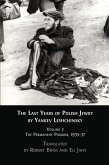Ukrainian-born Yankev Leshchinsky (1876-1966) was the leading scholarly and journalistic analyst of Eastern European Jewish socioeconomic and political life from the 1920s to the 1950s. Known as "the dean of Jewish sociologists" and "the father of Jewish demography," Leshchinsky published a series of insightful and moving essays in Yiddish on Polish Jewry between 1927 and 1937. Despite heightened interest in interwar Jewish communities in Poland in recent years, these essays (like most of Leshchinsky's works) have never been translated into English. The Last Years of Polish Jewry helps to rectify this situation by translating some of Leshchinsky's key essays. A thoughtful Introduction by Robert Brym provides the context of the author's life and work. The essays in this volume, based on years of research and first-hand observation, focus on the period 1927-33. The rise of militant Polish nationalism and the ensuing anti-Jewish boycotts and pogroms; the increasing exclusion of Jews from government employment and the universities; the destitution, hunger, suicide, and efforts to emigrate that characterized Jewish life; the psychological toll taken by mass uncertainty and hopelessness-all this falls within the author's ambit. There is no work in English that comes close to the range and depth of Leshchinsky's essays on the last years of the three million Polish Jews who were to perish at the hand of the Nazi regime. This book will be of interest to researchers and students of Eastern European history and society, especially those with an interest in Eastern Europe's Jewish communities on the brink of the Holocaust.
Dieser Download kann aus rechtlichen Gründen nur mit Rechnungsadresse in A, B, BG, CY, CZ, D, DK, EW, E, FIN, F, GR, HR, H, IRL, I, LT, L, LR, M, NL, PL, P, R, S, SLO, SK ausgeliefert werden.









